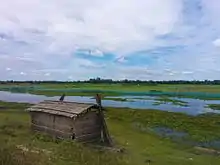Villages of Bangladesh
A village is a clustered human settlement or community, larger than a hamlet but smaller than a town, with a population ranging from a few hundred to a few thousand. In Bangladesh, a village is the smallest territorial and social unit for administrative and representative purposes.[1] It is an elective unit of a Union Council from which a single council member is elected. Usually one village is designated as a ward and each union is made up of nine villages.


At the 1991 census, there were 68,038 villages in Bangladesh with an average of 232 households.[1] The rural areas of Bangladesh (i.e. villages) are characterized by higher growth rate of population and lower literacy rate compared to urban areas - but these gaps are decreasing.[2] After independence the villages in Bangladesh were underdeveloped in terms of infrastructure and economic activity. Traditional manual process driven agriculture used to be the predominant economic activity. However, the ingenuity and vitality demonstrated by the people is gradually driving the villages towards economic progress.[3]
See also
References
- Sirajul Islam (2012). "Village". In Sirajul Islam and Ahmed A. Jamal (ed.). Banglapedia: National Encyclopedia of Bangladesh (Second ed.). Asiatic Society of Bangladesh.
- "Bangladesh Statistics 2017" (PDF). Bangladesh Bureau of Statistics (BBS). Retrieved 21 October 2019.
- Briscoe, J. (Oct 2001). "Two Decades of Change in a Bangladeshi Village". Economic and Political Weekly. 36 (40): 3823–3828. JSTOR 4411199.
| Wikimedia Commons has media related to Villages in Bangladesh. |
